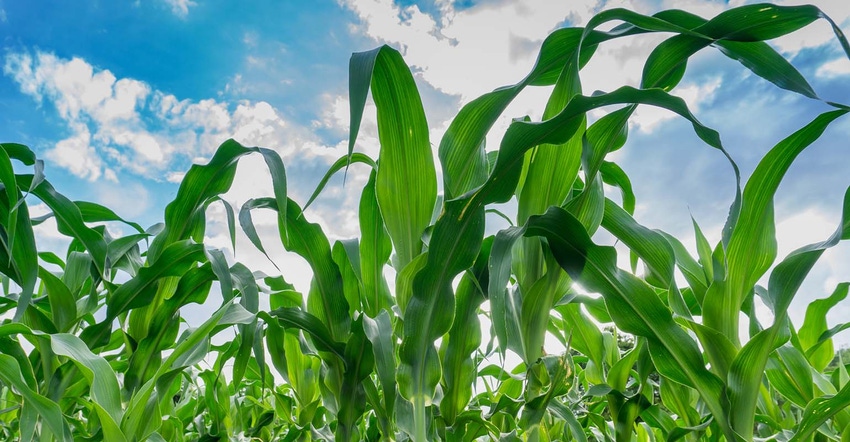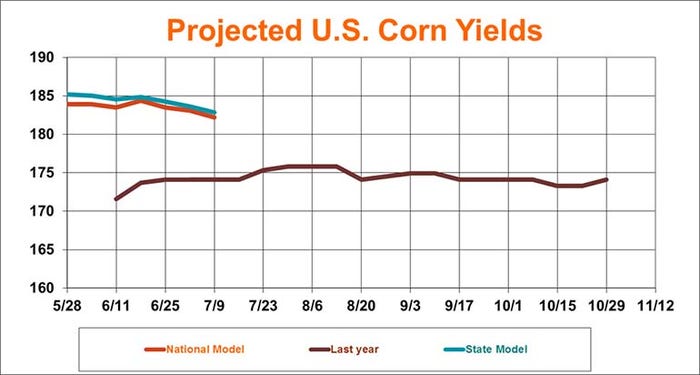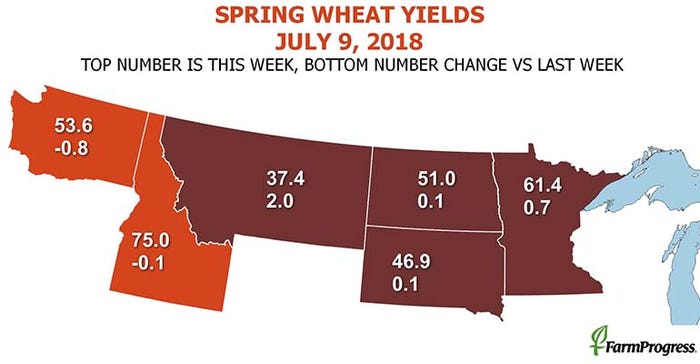
The latest USDA Crop Progress report, out Monday afternoon, shows this year’s 2018 corn crop quality slipping for a second consecutive week, while soybean condition remains unchanged from the prior week. Winter wheat harvest moves another 12% closer to completion.
The latest USDA corn quality assessment, for the week ending July 8, has this year’s crop moving from 76% in good-to-excellent condition down to 75%. That is in line with what a group of analysts had predicted prior to the latest report’s release. Many of the nation’s top-producing states continue to find significantly more than half of their crop still rated good to excellent, with a few notable exceptions that include Texas (38%), North Carolina (40%) and Missouri (48%).
“While yield potential remains good for crops growers planted this spring, signs of stress emerged in some areas following a week of hot and mostly dry weather,” says Farm Futures senior grain market analyst Bryce Knorr. “Our average corn yield projection based on USDA’s crop ratings is down nearly a bushel per acre nationwide but is still running around 182.5 bushels per acre if conditions hold into harvest. Even factoring that the crop is just pollinating, yields could still average 179 bpa.”


Knorr notes that statistically speaking, it’s harder to produce major damage to the crop from not until harvest.
“Weekly ratings in the second week of July account for about two-thirds of the variance in corn yields from year to year, with the low end of the yield range 169 bpa,” he says. “That would be below average, but not by much.”
Physiologically, the corn crop remains well ahead of recent years, with 37% reaching the silking stage as of July 8. That’s more than double the pace of 2017 and the five-year average, both at 18%. Illinois (76%), Missouri (76%), North Carolina (82%) and Tennessee (83%) lead the charge so far.
Soybean condition as of July 8 held steady, with 71% of the crop in good-to-excellent condition. Trade analysts expected that number to slip to 70%. Of the top production states, only Missouri (48%) and North Carolina (45%) failed to see at least half of its crop in good-to-excellent condition.
“Though the percentage of the soybean crop rated good to excellent held steady, overall conditions declined, taking about a third of a bushel off yield potential,” Knorr says. “The ratings suggest yields could hit 51.6 bushels per acreage if conditions hold, though there’s still plenty time for conditions to change since the crop won’t be made until August. The bottom end of the range based on ratings in the second week in 45.5 bpa, around 3 bpa lower than USDA’s current forecast of the average yield.”
Soybean crop progress is also trending well ahead of recent years. Nearly half – 47% – of the crop is now blooming, up from 2017’s pace of 32% and a five-year average of 27%. Another 11% of this year’s crop is setting pods, also up from 2017’s pace of 6% and a five-year average of 4%.


Spring wheat’s quality moved up three points, meantime, from 77% in good-to-excellent condition the prior week to 80% for the week ending July 8. Analysts had expected spring wheat quality to hold steady. South Dakota’s spring wheat crop, rated just 51% good-to-excellent, is the lone outlier among the six top production states.
“Spring wheat ratings improved, supporting our forecast for USDA to increase production in Thursday’s first estimate based on surveys of farmers and their fields,” Knorr says. “The ratings suggest yields of 51.6 bpa are possible, which could boost all-wheat production above 1.9 billion bushels.”
The 2018 U.S. spring wheat crop is also maturing relatively faster than in recent years, with 81% of the crop now headed. That’s compared to 76% a year ago and a five-year average of 69%.
Winter wheat harvest marches on, moving from 51% complete as of July 1 to 63% as of July 8 – much closer in line to the pace of 2017 (65%) as well as the five-year average (61%).


Sorghum’s crop progress is trending slightly behind so far, with 25% of the crop headed as of July 8, compared with 28% last year and a five-year average of 27%.
About the Author(s)
You May Also Like






